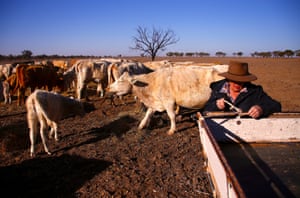Farmers will get up to $12,000 in cash payments to help them and their communities fight one of the worst droughts of the past century.
The prime minister, Malcolm Turnbull, on Sunday returned to a farm at Trangie in central New South Wales to announce the $190m relief package which includes a boost for mental health services.
He described some farmers’ situations as diabolical and tragic, as they battle dry conditions across large swathes of eastern and southern Australia.
“You put the food on our tables, the fibre that goes on our backs and we have your back,” he told reporters on Sunday.
It comes after the government in June extended the Farm Household Allowance scheme from three to four years.
The government is also changing the assets test to allow an estimated 8,000 more farmers to access support to recognise the severity of the drought. But how much difference the package will make is unclear.
Dairy farmer Ashley Gamble, from near Toowoomba in Queensland, is frightened about the future.
He said $12,000 might put food on the table for his children, but would go nowhere on the farm because it was less than the cost of a load of grain or hay.
“I wouldn’t wish this on anyone,” Gamble told the Nine Network on Sunday. “It’s like you are in jail every day. You turn up here because you’ve got to turn up. It’s just depressing.”
Turnbull defended the figure, promising to monitor the situation given grave forecasts of drought continuing through spring and summer.
“We are dealing with a dynamic situation. There’s no set and forget here,” Turnbull said.

Eligible farmers will receive the first payment on 1 September, with another round of funding to flow on 1 March next year.
The FHA allows farmers to access a payment equivalent to the unemployment benefit, worth about $16,000 a year.
The extra relief payment will allow couples to get up to $12,000, while singles will be able to access up to $7,200.
Turnbull said long-term measures to improve the resilience of rural communities to handle drought conditions were in the works.
As part of the government’s package, struggling farmers will no longer have to trek to town for counselling appointments under new measures to make seeking mental health support easier.
Turnbull announced the change on Sunday, along with $11.4m in funding for other initiatives supporting the mental wellbeing of farming families and their communities.
Instead of three out of 10 Medicare-supported psychological consultations needing to be in person, rural people can now access all of them over the phone or through Skype under the changes.
Turnbull said the government recognises the dry conditions have been taking a mental toll on farming communities. “These are bleak times and a lot of people find it very hard to cope,” he said.
“A lot of people don’t want to go into town, they don’t have the time to go into town, they’re shy about doing so.”
Eligible drought-affected communities will be able to apply for grants up to $1m to run mental health programs tailored to their needs. It is expected that communities will receive between $200,000 and $300,000 each.
Primary Health Networks will also get some of the money to help them cope with increasing demand for their mental health services.
Youth mental health organisation ReachOut will be funded to visit drought-affected communities to make young people more aware of their e-counselling services.
The initiatives have been embraced by the National Farmers’ Federation. “It’s vital that we help farmers and families that are dealing with the stress and pressures drought brings,” the NFF president, Fiona Simson, said in a statement.
Labor welcomed the drought relief package, but called on the government to ensure farmers seeking assistance could contact and access Centrelink.
“[That] has been made even more difficult since the Turnbull government cut almost 2,500 Centrelink jobs over the past two years,” the opposition’s agriculture spokesman, Joel Fitzgibbon, said in a statement.
Last week, Labor announced a policy to use agriculture-based research and development corporations to prepare farmers for future droughts.
On Sunday Queensland cabinet minister Kate Jones told reporters the federal government’s package would be welcome relief for those in the state battling the drought and the announcement was an example of the Coalition “finally listening to the needs of Australia”.
- The current drought is one of the worst in the past century.
- Autumn in 2018 was the fourth-warmest autumn on record, with rainfall totals below average for most of Australia.
- Last month was also the driest July nationally since 2002.
- In NSW, drought is affecting roughly 99% of the state, with the western, north-west, northern tablelands, Hunter, central west, central tablelands, Riverina and south-east regions hardest hit.
- About 58% of Queensland is in drought, with producer group AgForce saying parts of the state’s west and south have been drought-affected for more than six years.
- Along with parts of NSW and Queensland, rainfall deficiencies deepened in July in northern Victoria, eastern pastoral and southern agricultural regions of SA and southern Western Australia and its Gascoyne coast.
- On top of the dry conditions, there is a 50% chance of an El Niño weather event developing in spring 2018, which is linked with below average rainfall in Australia’s south-east.
• In Australia, the crisis support service Lifeline is on 13 11 14. For further support contact BeyondBlue on 1300 22 4636 or the Farmer Assitance Hotline on 132 316









 Add Category
Add Category
